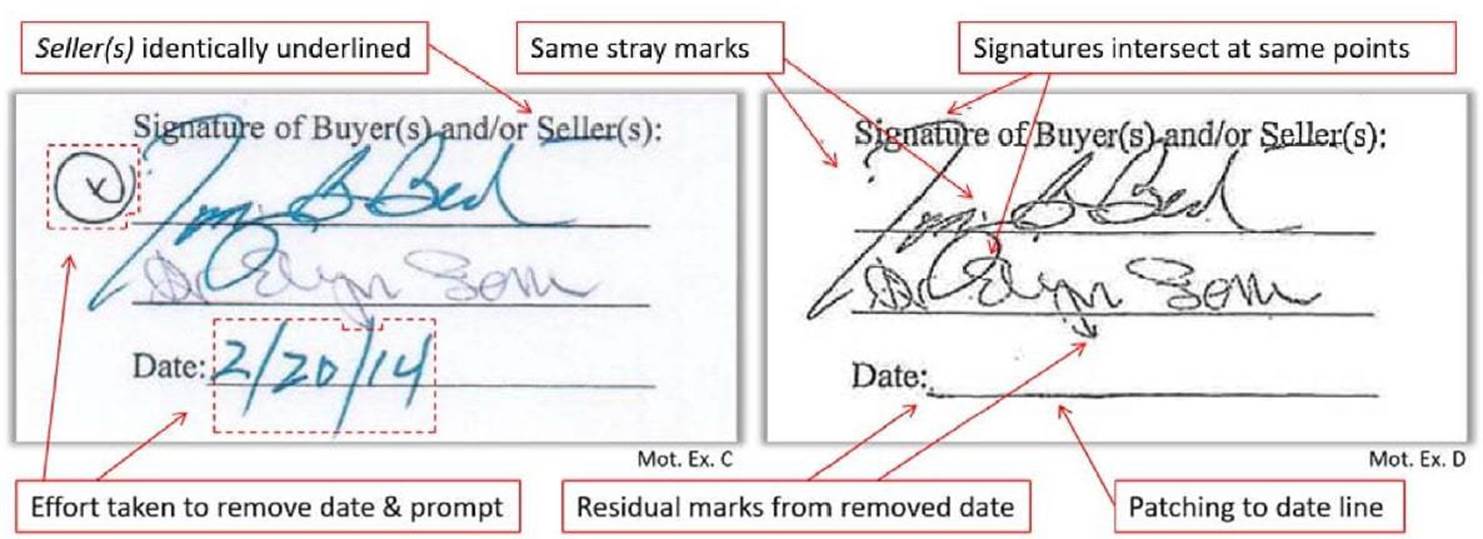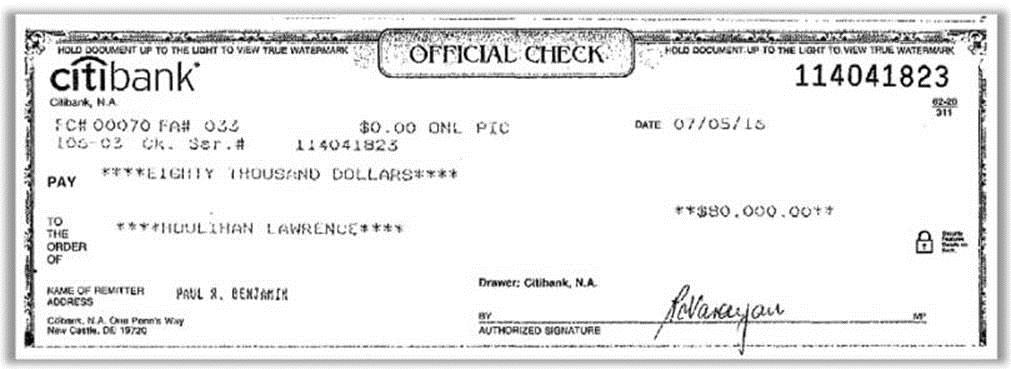Brokerage accused of forging documents in dual agency lawsuit
4 plaintiffs allege signatures on statutory disclosure form Houlihan Lawrence included in its legal filing are phony
Staff Writer
Clients are accusing top New York brokerage Houlihan Lawrence of forging disclosure forms in the firm’s effort to have their dual agency lawsuit dismissed.
In a lawsuit first filed in July and amended in October, four buyer and seller plaintiffs allege Houlihan Lawrence duped them into double-ended deals where the brokerage represented both buyer and seller, thereby committing breach of fiduciary duty and unjust enrichment, among other charges.
Anonymous letters sent to the plaintiffs’ law firm also allege the brokerage pays or paid its agents bonuses for keeping transactions in-house — a tactic that is not unheard of in the real estate industry but that plaintiffs allege encouraged double-sided transactions to boost the firm’s market share for its eventual acquisition by Berkshire Hathaway affiliate HomeServices of America.
Houlihan Lawrence owns and operates 30 offices with more than 1,300 agents in New York’s largely affluent Westchester, Putnam and Dutchess counties.
In a motion to dismiss the suit filed Oct. 30, attorneys for Houlihan Lawrence argue that since the buyer and seller plaintiffs each signed statutory disclosure forms consenting to Houlihan Lawrence’s dual agency with designated sales agents (i.e. with separate Houlihan Lawrence agents representing buyer and seller), their breach of fiduciary duty claims should be tossed.
But attorneys for homebuyers Pamela Goldstein and Paul Benjamin and sibling home sellers Tony Berk and Dr. Ellyn Berk argue that signed forms are not enough to fulfill a broker’s consent and disclosure obligations under New York state law, which requires fully informed consent.
“The Department of State and the state’s major trade association, NYSAR (New York State Association of Realtors), have recognized that ‘merely presenting the form to a prospective purchaser or seller is insufficient’ to fulfill a broker’s disclosure and informed consent duties,” plaintiffs’ attorneys at Boies Schiller Flexner LLP wrote in their opposition to the motion to dismiss, filed Nov. 20.
“[T]he Department of State explained that the form ‘does not and was not intended to relieve’ brokers of their ‘common law duty’ to ‘obtain informed consent through full disclosure of the implications of the proposed dual agency relationship’ — rather, the form is ‘the beginning of full disclosure,’ and is not a ‘substitution for the rigorous duties of full disclosure in the common law.’”
Dual agents must explain to both buyer and seller that the agent is acting for the other party as well and explain the possible effects of dual representation, including that their consent would mean they are giving up their right to undivided loyalty, according to the opposition filing.
In its motion to dismiss, “Houlihan Lawrence does not and cannot contend that it fully disclosed the risks, downsides, and options of dual agency, as it was duty-bound to do,” plaintiffs’ attorneys added.
‘Sham’ disclosure forms
Moreover, they allege that the signatures on one of the statutory disclosure forms Houlihan Lawrence included in its legal filing are phony — copied and pasted from another form.
“Its proffered documentary evidence has revealed a new element of Houlihan Lawrence’s dual-agency scheme: fabricating sham statutory disclosure forms. The motion features … an undated statutory disclosure form which Houlihan Lawrence claims Plaintiffs Tony and Ellyn Berk signed. But inspection of the document shows that the signatures on that form were copied and pasted from a prior, differently marked form — all without the Berks’ knowledge or consent,” plaintiffs’ attorneys wrote.
Screen shot from plaintiffs’ opposition to defendants’ motion to dismiss
Houlihan Lawrence’s apparent practice of creating “sham” statutory disclosure forms confirms the brokerage’s “culture of disregard for client consent,” they added. “And it is yet another reason why statutory disclosure forms, standing alone, cannot establish disclosure and informed consent as a matter of law.”
Asked to comment on the allegations, a spokesperson for Houlihan Lawrence said in an emailed statement Wednesday, “For more than 130 years, Houlihan Lawrence has had a reputation of responsible business practices and integrity. We believe this lawsuit is meritless and intend to vigorously defend against plaintiffs’ claims.”
Claims ‘unique’ or part of a ‘scheme’?
The lawsuit seeks class-action status and aims to represent all buyers and sellers of residential real estate in Westchester, Putnam, and Dutchess counties from January 1, 2011 to the present where Houlihan Lawrence represented both the buyer and seller in the same deal.
In its motion to dismiss, Houlihan Lawrence contends that claims regarding real estate transactions where the facts are “unique” to each plaintiff cannot have a broad impact on consumers at large and should not be covered under a class action.
“The fact of customer consent is case and individual specific. That is one reason why Plaintiffs’ breach of fiduciary claim cannot be maintained on a class basis. Common proof of consent is impossible and requires individual inquiries and individual trials,” wrote attorneys for Houlihan Lawrence at Collier Halpern & Newburg LLP.
However, plaintiffs’ attorneys argue that Houlihan Lawrence’s conduct has affected all class members and involve common questions of fact and law.
“Its class certification arguments ignore the fact that this case is based on Houlihan Lawrence’s firm-wide scheme to steer clients into undisclosed, non-consensual dual agent transactions, including through secret dual-agency kickbacks to its agents and a long list of other deceptive and unfair practices,” they wrote.
In its motion to dismiss, Houlihan Lawrence does not dispute that it never told the plaintiffs “that it financially incentivizes its agents to steer clients into dual-agent transactions,” they added. That undermines consumers’ ability to make an informed decision about dual agency and hurts the public, they wrote.
Does it matter who paid the commissions?
Houlihan Lawrence’s attorneys maintain that the unjust enrichment claims from homebuyer plaintiffs Goldstein and Benjamin should be dismissed because they did not pay any commission in their transactions and therefore Houlihan Lawerence did not benefit at their expense.
“Anyone who has sold a home knows that the seller pays the entire commission. The buyer Plaintiffs’ transactions were no different,” they wrote.
“The sellers agreed to pay a 5 percent commission rate and actually paid that amount at or after the closing. The buyer Plaintiffs are not entitled to recover any portion of a commission they did not pay.”
But plaintiffs’ attorneys note that the Federal Trade Commission and Department of Justice disagree with Houlihan Lawrence’s position. In a 2007 report, the agencies said that “because the amount home sellers pay their real estate broker is built into the home sales price, both home buyers and sellers bear this expense.”
“Illustrating this well-recognized economic reality, Houlihan Lawrence admits that it collected a sales commission of $80,000 in connection with buyer Plaintiff Paul Benjamin’s transaction –and received a check from him in that amount at closing,” plaintiffs’ attorneys wrote.
Screen shot of Paul Benjamin’s check to Houlihan Lawrence in plaintiff’s opposition to motion to dismiss
Even if the buyers in a dual agency transaction didn’t pay Houlihan Lawrence directly, that doesn’t mean the brokerage didn’t benefit because it still received more in commission money, according to plaintiffs’ attorneys.
“Had another broker represented those buyer-Plaintiffs — a broker who was not a dual agent and could therefore faithfully represent the buyer-Plaintiffs — that commission money would have gone to the faithful broker instead of Houlihan Lawrence,” they wrote.
“Houlihan Lawrence eagerly represents buyer clients all the time — not out of charity, but for the financial benefit of the commission money it receives for doing so.”
Your Title Goes Here
Your content goes here. Edit or remove this text inline or in the module Content settings. You can also style every aspect of this content in the module Design settings and even apply custom CSS to this text in the module Advanced settings.


